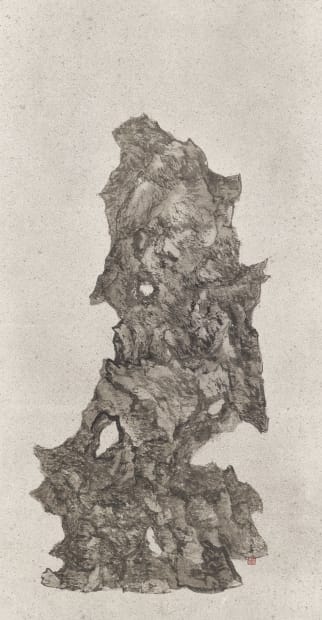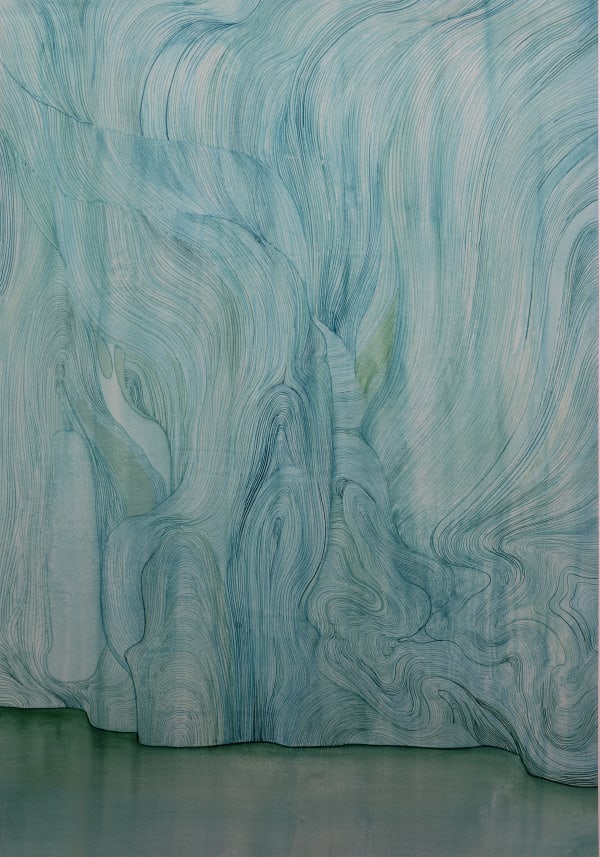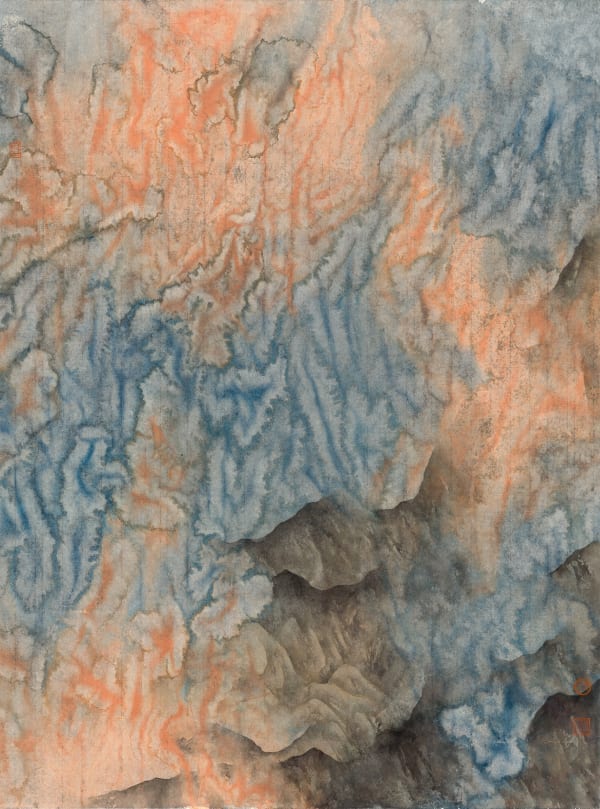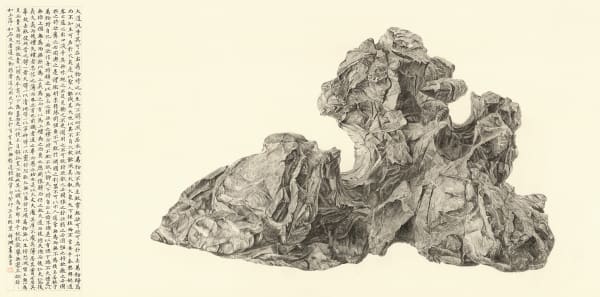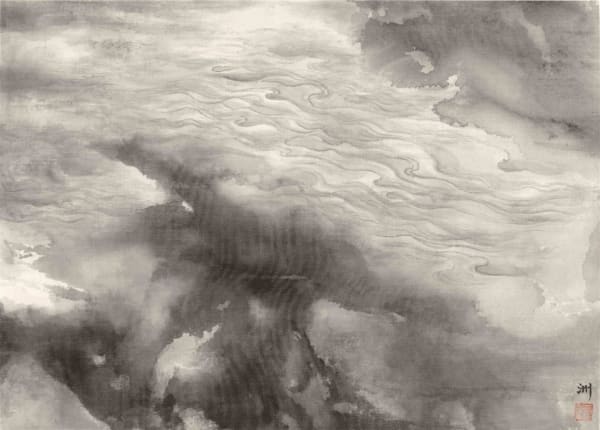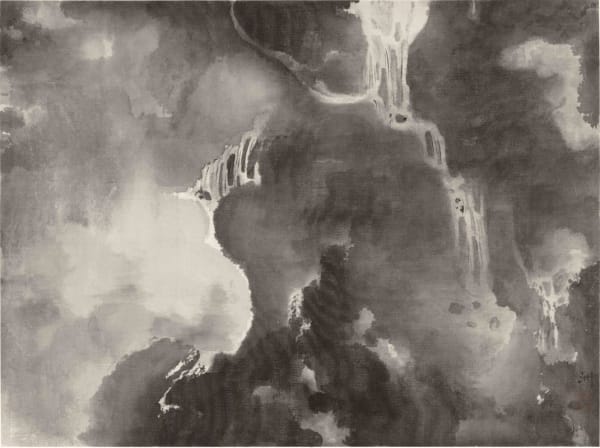-

-
Chapter One
"Scholar Rocks"The highlight of this exhibition is a precious handscroll, "Wondrous Rocks," by the Ming Dynasty painter and calligrapher Sun Kehong (1532-1610), depicting twelve uniquely shaped rocks. Sun's depiction of scholar rocks not only influenced the Ming Dynasty literatus Dong Qichang (1555-1636), who inscribed colophons on Sun’s art, but also later artists like Lan Ying (1585-1664). Additionally, the exhibition will present works by contemporary artists who continue to innovate on the theme of scholar rocks, including C.C.Wang (1907-2003), Chen Duxi (b. 1983), Zhang Xiaoli (b. 1989), Tai Xiangzhou (b. 1968), and Wang Mansheng (b. 1962).
-
 SUN KEHONG (1532-1610)Wondrous RocksInk and color on paper, Handscroll11 1/4 x 108 3/4 in
SUN KEHONG (1532-1610)Wondrous RocksInk and color on paper, Handscroll11 1/4 x 108 3/4 in
(28.6 x 276.2 cm)Sun Kehong (1532-1610), styled Yunzhi, and known as Xueju, was the son of Sun Cheng'en (1482-1561), the Minister of Rites during the Jiajing era of the Ming dynasty. Sun Cheng'en served as the chief examiner in the imperial examination in the 26th year of the Jiajing Reign, becoming the teacher of many important Ming officials such as Li Chunfang (1510-1584), Yang Jisheng (1516-1555), Zhang Juzheng (1525-1582), and Wang Shizhen (1526-1590). Although Sun Kehong inherited an official position as the prefect of Hanyang through his father's influence, his early experiences in office led him to see through the darkness of the bureaucratic world, and he was unwilling to become a victim of political struggles. Consequently, he returned to his hometown in Songjiang, where he continued to renovate his father's "Dongguo Thatched Cottage," transforming it into a manor for his reclusive life. There, he leisurely entertained guests and pursued his calligraphy and painting. Famous literati of the Songjiang region, such as Mo Shilong (1539-1587), Dong Qichang (1555-1636), and Chen Jiru (1558-1639), were frequent visitors.
The "Dongguo Thatched Cottage" was so well renovated that it even made Dong Qichang envious. Dong expressed his admiration on Sun Kehong's "Seven Rocks" scroll, housed in the Beijing Palace Museum, saying, "I will gift him a painting by Mi (Mi Fu, 1051-1107), only wishing to exchange for a piece of the brilliant clouds in front of Dongguo Thatched Cottage; that would suffice." Sun Kehong was primarily known for his flower and bird paintings, but his rock works not only inspired Dong Qichang to write inscriptions for them but also influenced other painters like Lan Ying (1585-1664) in their creation of rock paintings.
The scroll "Wondrous Rocks” showcases such influence. It depicts twelve rocks of varying postures, arranged near and far, standing or lying, with colors ranging from deep to light. Some resemble distant landscapes, some look like Mi Fu's inkstones, and others appear as if they were taken from a landscape painting, each inviting prolonged contemplation. According to the inscription, Sun Kehong created this piece while still serving as an official in Hanyang, making it one of his early works. The original models for these rocks were likely from the stones collected and cataloged by Mi Fu. From a painting perspective, this work is somewhat different from Sun Kehong's other rock styles, using shorter lines and dots with drier ink. However, this style of painting provided a clear stylistic source for Lan Ying's rock paintings. As one of the first literati Lan Ying visited in the Songjiang region, Sun Kehong not only offered Lan Ying the opportunity to meet people like Dong Qichang but also provided significant intellectual guidance for Lan Ying's later creations.
-
-
 C. C. WANG, Scholar Rock, 2001, Ink on paper, 54 1/2 x 28 3/4 in (138.3 x 73 cm)
C. C. WANG, Scholar Rock, 2001, Ink on paper, 54 1/2 x 28 3/4 in (138.3 x 73 cm) -
-
 ZHANG XIAOLI, Rubik’s Rock Cube, 2024, Ink and Gold on Paper, 25 5/8 x 25 5/8 in (65 x 65 cm)
ZHANG XIAOLI, Rubik’s Rock Cube, 2024, Ink and Gold on Paper, 25 5/8 x 25 5/8 in (65 x 65 cm) -
-
Tai Xiangzhou (b. 1968) has long concentrated on rejuvenating the idealistic forms of traditional Chinese landscape painting and researching on the origin and development of “Mountain and Water Representation” (Shan Shui Tu Xiang). The Kun Lun series merges the tangible and metaphysical, symbolizing both the mountain in China and its spiritual essence. TAI's exploration introduces fantastical creatures from this otherworldly realm, notably dragons, phoenixes, and qilins. Departing from conventional landscape depictions, Tai portrays the cosmos itself, using ink blots on silk to evoke its chaotic nature. Inspired by Chinese mythology, he incorporates Han Dynasty motifs into his compositions.
Accompanying calligraphic verses from classical Chinese literature deepen the narrative, describing Kunlun's mystical landscape and inhabitants. The series invites viewers into a hyperreal dimension where celestial wonders merge with mythical beings, echoing the timeless allure of Kunlun.
-
 TAI XIANGZHOU Kunlun - Su Dynasty of Xuan Yun 昆仑——玄云之素朝, 2023 Ink on Silk 12 1/2 x 50 5/8 in (31.8 x 128.6 cm)
TAI XIANGZHOU Kunlun - Su Dynasty of Xuan Yun 昆仑——玄云之素朝, 2023 Ink on Silk 12 1/2 x 50 5/8 in (31.8 x 128.6 cm) -
Chapter Two
"Calligraphy"The exhibition also features ancient and modern literati calligraphy works, including Dong Qichang's "Ruan Ji’s Essay and Excerpt from Zhao Zhi’s Essay in Running Script." Dong Qichang, an important Ming Dynasty painter, connoisseur, and art theorist, proposed the theory of the Southern and Northern Schools of Chinese landscape painting in his book Huazhi 画旨("The aims of painting" )It deeply influenced the painting theory of the Ming and Qing Dynasties, as well as the formation of the "Nanga" genre during the Edo period in Japan, and affected the understanding of painting itself and Chinese landscape painting history, even extending to the theoretical construction of calligraphy, poetry, and other related art forms.
In the section dedicated to modern and contemporary calligraphy, we will showcase a variety of styles and influences. Among them, we will feature seal script couplets by Wang Fu’an (1880-1960), a founding member of the Xiling Seal Art Society in 1904, cursive script couplets by Wu Hufan (1894-1968), cursive script couplets by literati calligrapher Bai Jiao (1907-1969), dancing ink calligraphy by scholar Wang Fangyu (1913-1997), conceptual calligraphy by Fung Ming Chip (b. 1951), all resonating with classical calligraphic traditions. We will also debut Michael Cherney's (b. 1969) latest bilingual calligraphy series "Within the Gates," aiming to create bilingual art for those dwelling in (or navigating back and forth) between cultures.
-
 DONG QICHANG (1555-1636) Ruan Ji’s Essay and Excerpt from Zhao Zhi’s Essay in Running Script ink on paper, handscroll 9 5/8 x 82 7/8 in (24.5 x 210.5 cm)
DONG QICHANG (1555-1636) Ruan Ji’s Essay and Excerpt from Zhao Zhi’s Essay in Running Script ink on paper, handscroll 9 5/8 x 82 7/8 in (24.5 x 210.5 cm)Dong Qichang, an eminent figure in the annals of Chinese calligraphy and painting, has consistently been the subject of meticulous study. Born in 1555, Dong Qichang secured second place in the imperial examination at 17 years old, his calligraphy skills deemed inadequate, a situation made more awkward by his nephew, Dong Yuanzheng, clinching first place. This spurred Dong Qichang to redouble his efforts in mastering calligraphy. He began his studies with Mo Ruzhong (1509-1589) and later forged a lasting friendship with Mo Ruzhong's son, Mo Shilong (1539-1587). The groundbreaking "Southern and Northern Schools" theory, which Mo Shilong proposed and Dong Qichang significantly advanced, revolutionized the traditional views of Chinese calligraphy and painting history. By the age of 23, Dong Qichang found employment under Lu Shusheng (1509-1605), who rose to become the Minister of Rites, a position facilitated by the prior acquaintance between Dong's father and Lu Shusheng. The Lu family provided Dong with considerable support, allowing him not only to pass the imperial examination alongside Lu Shusheng's son, Lu Yanzhang (1566-1631), but also to embrace the Lu family's Zen Buddhist practice and philosophy. This deeply influenced his later advocacy for the "Southern and Northern Schools" theory and the concept of "directly entering the realm of the Tathagata." Moreover, Dong Qichang had the good fortune of meeting Xiang Yuanbian (1525-1590), the era's most renowned collector of paintings and calligraphy, which significantly enhanced his discernment through access to Xiang's collection. Such mentors played a crucial role in shaping Dong Qichang into the figure he became. A defining feature of Dong Qichang's calligraphy, widely recognized, is its "vitality" — not a vitality borne of neglect but, in his words, a result of maturation that brings life to calligraphy. Mastery enables the calligrapher to employ unconventional techniques for unexpected effects during the fleeting moments of brush movement. Without sufficient skill, a calligrapher may overly concentrate on character shapes and brushwork, lacking the mental bandwidth for deeper artistic reflection. This philosophy is exemplified in his exhibition piece "Ruan Ji's Memorial to Lord Jiang and Excerpt of Zhao Zhi's Letter to Ji Maoqi in Running Script." Dong Qichang offered insights on the calligraphic styles of renowned Tang dynasty calligraphers Yu Shinan (558-638) and Chu Suiliang (597-658), critiquing their adherence to traditional constraints, in contrast to Yan Zhenqing (708-785), whom Dong esteemed for surpassing such limitations. Despite their significant contributions to Chinese calligraphy, evaluating them purely on technique is challenging. It's suggested that Yu and Chu's approach was more narrowly focused on calligraphic artistry, whereas Yan Zhenqing's legacy includes not only his artistic output but also his valorous acts of leadership and sacrifice for his country. Dong Qichang's observations on the distinctiveness of Yan Zhenqing's calligraphy may well derive from these aspects.
A defining feature of Dong Qichang's calligraphy, widely recognized, is its "vitality" — not a vitality borne of neglect but, in his words, a result of maturation that brings life to calligraphy. Mastery enables the calligrapher to employ unconventional techniques for unexpected effects during the fleeting moments of brush movement. Without sufficient skill, a calligrapher may overly concentrate on character shapes and brushwork, lacking the mental bandwidth for deeper artistic reflection. This philosophy is exemplified in his exhibition piece "Ruan Ji's Memorial to Lord Jiang and Excerpt of Zhao Zhi's Letter to Ji Maoqi in Running Script." Dong Qichang offered insights on the calligraphic styles of renowned Tang dynasty calligraphers Yu Shinan (558-638) and Chu Suiliang (597-658), critiquing their adherence to traditional constraints, in contrast to Yan Zhenqing (708-785), whom Dong esteemed for surpassing such limitations. Despite their significant contributions to Chinese calligraphy, evaluating them purely on technique is challenging. It's suggested that Yu and Chu's approach was more narrowly focused on calligraphic artistry, whereas Yan Zhenqing's legacy includes not only his artistic output but also his valorous acts of leadership and sacrifice for his country. Dong Qichang's observations on the distinctiveness of Yan Zhenqing's calligraphy may well derive from these aspects.
-
-

-
In the contemporary realm of calligraphy, calligraphers are consistently pushing the boundaries set by conventional frameworks of the art form. Fung Ming Chip(b. 1951) mainly works with calligraphy and seal carving, reframing both through his conceptualization of space, time, and lines. By inventing scripts and writing procedures from ground up, Fung invites viewers to expand their understanding of calligraphy on various fronts. The writing of Fung’s scripts sometimes involves the use of new tools not traditionally associated with calligraphy; it sometimes requires Fung to rearrange the tools and materials of writing. In most of Fung’s calligraphic pieces, the characters verge between emergence and disappearance, veering in and out of the relief-like space demarcated by the xuan paper.
-
 MICHAEL CHERNEY, MacEwen, from the Within the Gate series, 2023, Photography and bilingual calligraphy; ink on Mitsumata paper 15 1/2 x 30 3/8 in (39.25 x 77.25 cm)
MICHAEL CHERNEY, MacEwen, from the Within the Gate series, 2023, Photography and bilingual calligraphy; ink on Mitsumata paper 15 1/2 x 30 3/8 in (39.25 x 77.25 cm)As a calligrapher and photographer, Michael Cherney aims to create bilingual art for individuals inhabiting or navigating between cultures in his latest series, Within the Gate《其間》. Translating poetry across diverse cultural backgrounds presents distinct challenges, requiring more than literal translation. As a bilingual artist, Cherney's focus is on preserving the poem's rhythm and essence, adapting certain elements to resonate within a new cultural milieu.
Through this artistic reinterpretation in in calligraphic form, the poetry's beauty transcends linguistic barriers, extending an invitation to a wider, more diverse audience to delve into its depth and resonance. Simultaneously, it provokes contemplation on fostering bridges of mutual understanding and dialogue amidst today's increasingly fragmented cultural landscape.
-
 MICHAEL CHERNEY, Longfellow, from the Within the Gate series, , 2023, Photography and bilingual calligraphy; ink on Mitsumata paper, 19 5/8 x 30 3/8 in (49.75 x 77.25 cm)
MICHAEL CHERNEY, Longfellow, from the Within the Gate series, , 2023, Photography and bilingual calligraphy; ink on Mitsumata paper, 19 5/8 x 30 3/8 in (49.75 x 77.25 cm) -
Chapter Three
"Nature"The Chinese landscape tradition represents an ideal harmony between humans and nature. Ancient and modern artists use their unique expressions to present their unique poetic perceptions of the natural world. Zhang Yirong (b.1979) ’s delicate ink drawings of flowers and plants evoke the purity and tranquility of nature. Arnold Chang's (b. 1954) newest "Boneless Landscape, Yau Wing Fung’s “Meta III”, Chen Shaomei's (1909-1954) "Distant Clouds Returning to the Mountain Peaks" as well as Tao Lengyue's (1895-1985) "Beyond the Dark Willows and Bright Flowers," showcase the exploration and development of the use of color in landscapes by ink artists over the past century.
Furthermore, under the theme of nature, Japanese-American artist Hisao Hanafusa (b. 1937) explores the pan-East Asian philosophical concept of "power borrowing," utilizing physical phenomena of natural elements such as light, gravity, humidity, and time. Through controlled experiments conducted in his studio, the artist's unique mediums and environments react to reveal the inherent beauty of the unseen world, blurring the boundaries between human action and natural forces.
-
-
 ARNOLD CHANG, Boneless Landscape, 2022, color on paper, 49 1/4 x 29 1/2 in (125.1 x 74.9 cm)
ARNOLD CHANG, Boneless Landscape, 2022, color on paper, 49 1/4 x 29 1/2 in (125.1 x 74.9 cm) -
 HISAO HANAFUSA, Fifth Dimension , Aluminum paint on paper, 30 x 22 1/2 in (76.2 x 57.1 cm)
HISAO HANAFUSA, Fifth Dimension , Aluminum paint on paper, 30 x 22 1/2 in (76.2 x 57.1 cm) -
 YAU WING FUNG, Floating Mountain XI, 2022, Ink and Color on Paper, 54 1/8 x 27 1/8 in (137.2 x 68.9 cm)
YAU WING FUNG, Floating Mountain XI, 2022, Ink and Color on Paper, 54 1/8 x 27 1/8 in (137.2 x 68.9 cm) -
-
-
 Chen Duxi, Contemplate #89, 2024
Chen Duxi, Contemplate #89, 2024 -
 Zhang Xiaoli, Rubik’s Rock Cube 魔方石 , 2024
Zhang Xiaoli, Rubik’s Rock Cube 魔方石 , 2024 -
 Hisao Hanafusa, Fifth Dimension
Hisao Hanafusa, Fifth Dimension -
 Bai Jiao, Calligraphy Couplet in Cursive Script 草書七言聯
Bai Jiao, Calligraphy Couplet in Cursive Script 草書七言聯 -
 Wang Mansheng, Ling Bi -Recalling the Past 靈璧懷古, 2019
Wang Mansheng, Ling Bi -Recalling the Past 靈璧懷古, 2019 -
 Wang Ti 王禔 1880-1960, Calligraphy Couplet in Seal Script 篆書六言聯, 1946
Wang Ti 王禔 1880-1960, Calligraphy Couplet in Seal Script 篆書六言聯, 1946 -
 Wu Hufan, Calligraphy Couplet in Running Script 行書七言聯
Wu Hufan, Calligraphy Couplet in Running Script 行書七言聯 -
 Tao Lengyue, Beyond the Dark Willows and Bright Flowers 柳暗花明, 1925
Tao Lengyue, Beyond the Dark Willows and Bright Flowers 柳暗花明, 1925 -
 Michael Cherney, MacEwen, 2023
Michael Cherney, MacEwen, 2023 -
 Michael Cherney, Longfellow, 2023
Michael Cherney, Longfellow, 2023 -
 Michael Cherney, Merwin, 2024
Michael Cherney, Merwin, 2024 -
 Dong Qichang (1555-1636), Ruan Ji’s Essay and Excerpt from Zhao Zhi’s Essay in Running Script
Dong Qichang (1555-1636), Ruan Ji’s Essay and Excerpt from Zhao Zhi’s Essay in Running Script -
 Sun Kehong (1532-1610), Wondrous Rocks
Sun Kehong (1532-1610), Wondrous Rocks -
 Arnold Chang, Landscape, 2023
Arnold Chang, Landscape, 2023 -
 Arnold Chang, Landscape, 2023
Arnold Chang, Landscape, 2023 -
 Arnold Chang, Boneless Landscape 2022.06, 2022
Arnold Chang, Boneless Landscape 2022.06, 2022 -
 Yau Wing Fung, Meta-3, 2024
Yau Wing Fung, Meta-3, 2024 -
 Yau Wing Fung, Hazy Mirage VII 蜃暮 07 , 2023
Yau Wing Fung, Hazy Mirage VII 蜃暮 07 , 2023 -
 Yau Wing Fung, Hazy Mirage VIII 蜃暮 08 , 2024
Yau Wing Fung, Hazy Mirage VIII 蜃暮 08 , 2024 -
 Tai Xiangzhou, Kunlun Jieshi 昆仑碣石, 2022
Tai Xiangzhou, Kunlun Jieshi 昆仑碣石, 2022 -
 Tai Xiangzhou, The Milky Way — Drifting Far into the Boundless 银河— 远沦于无涯, 2023
Tai Xiangzhou, The Milky Way — Drifting Far into the Boundless 银河— 远沦于无涯, 2023 -
 Tai Xiangzhou, The Milky Way — The Softest under Heaven, Moving Through the Hardest 银河— 天下至柔,驰骋天下之至坚, 2023
Tai Xiangzhou, The Milky Way — The Softest under Heaven, Moving Through the Hardest 银河— 天下至柔,驰骋天下之至坚, 2023 -
 Tai Xiangzhou, The Milky Way — Exchange with Heaven and Earth 银河— 与天地取与, 2023
Tai Xiangzhou, The Milky Way — Exchange with Heaven and Earth 银河— 与天地取与, 2023 -
 Tai Xiangzhou, Springtime Vignette 春日小景, 2023
Tai Xiangzhou, Springtime Vignette 春日小景, 2023 -
 Tai Xiangzhou, Dawn of an Early Spring 早春晨曦, 2023
Tai Xiangzhou, Dawn of an Early Spring 早春晨曦, 2023 -
 Tai Xiangzhou, Kunlun — The Pure Dawn of Mysterious Clouds 昆仑 — 玄云之素朝, 2023
Tai Xiangzhou, Kunlun — The Pure Dawn of Mysterious Clouds 昆仑 — 玄云之素朝, 2023 -
 Yau Wing Fung, Floating Mountain XI, 2022
Yau Wing Fung, Floating Mountain XI, 2022 -
 C. C. Wang 王季遷 1907-2003, Scholar Rocks 太湖石, 2001
C. C. Wang 王季遷 1907-2003, Scholar Rocks 太湖石, 2001 -
 Wang Mansheng, Rocks on Travels Down the Gan River 下灨石, 2013
Wang Mansheng, Rocks on Travels Down the Gan River 下灨石, 2013 -
 Fung Ming Chip, Luminous Script: Ripples of Light 流水光形字, 1999
Fung Ming Chip, Luminous Script: Ripples of Light 流水光形字, 1999 -
 Fung Ming Chip, 影字扇面 大地寂静 , 1997
Fung Ming Chip, 影字扇面 大地寂静 , 1997 -
 Fung Ming Chip, Reflection of Zen 禅倒影 , 2007
Fung Ming Chip, Reflection of Zen 禅倒影 , 2007 -
 Wang Fangyu, Calligraphy: Ink Pond 墨池
Wang Fangyu, Calligraphy: Ink Pond 墨池 -
 Fung Ming Chip, Zoom in/out Series 物质变化 , 2001
Fung Ming Chip, Zoom in/out Series 物质变化 , 2001
-
Asia Week New York Exhibition, 14 March - 13 April 2024
Join our mailing list
* denotes required fields
We will process the personal data you have supplied to communicate with you in accordance with our Privacy Policy. You can unsubscribe or change your preferences at any time by clicking the link in our emails.




